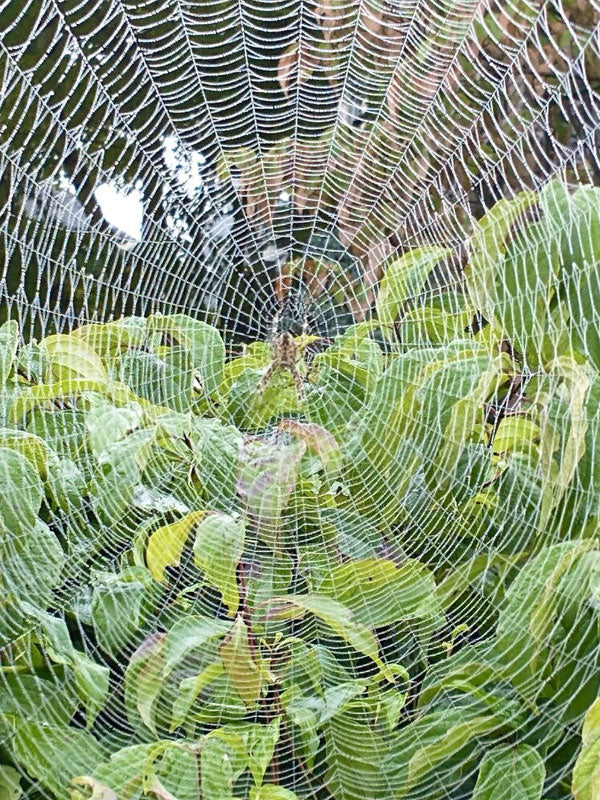
If you gathered up all the spiders in the world and placed them onto one gigantic scale, they would weigh more than 25 million tons. To put that into perspective, that’s more than five million average sized elephants or 478 Titanics. Wow. For years when anyone in our family spotted a large spider in the house it went something like this:
Find a large glass, grab a piece of paper, quickly but gently place glass over large, unwanted and often terrifying looking spider, slide paper under lip of glass careful not to break off any of the 8 surprising furry legs in the process, walk briskly to the front door, open and toss spider into the front yard all the while congratulating yourself on a job well done. Humane, easy, better for everyone. Right? Well, turns out we should hold the applause.
In most cases, putting something ‘back out’ to where it didn’t come from in the first place is usually a death sentence. Although a few spiders are able to adapt, most spiders we see in our houses are exactly that, house spiders. They won’t generally survive in their newfound outdoor habitat. Dang it.

Ok, so, what to do?
To be clear, I’m not advocating you ignore dangerous spiders in your home like brown recluse or black widows. Those will be quickly squashed if they come out of their hiding places, but they don’t. Honestly, I’ve grown up in the Pacific Northwest, the spider capital of the world, and seen one black widow in my entire life, and it wasn’t in the house. I wonder how often we actually do run into potentially harmful spiders as opposed to harmless spiders in our homes? The overwhelming majority of the spiders we see, even the big, scary, threatening looking ones, are harmless.
Most of the time, we have two choices: one, kill the spider out of instinct and go on your way feeling like you’ve rid the house of danger ( a lovely thought and nowhere near the truth considering the sheer number of spiders quietly living in all our homes). The estimated global average spider density is between 130-150 spiders for every 10 square feet.
But I’m here to suggest an alternative: leave them alone. Or, if you feel the urge to be proactive, chase it into a crevice or corner so you don’t need to see it. Better still, wave as you pass by and say “Thank You!” because the truth is, house spiders are beneficial. I know, most of you aren’t convinced but please hear me out.
House spiders eat fleas, flies, roaches, earwigs, moths, mosquitoes and other unwanted and potentially harmful insects in our homes. In fact, one spider can eat up to 2,000 insects in just one year! They also eat other spiders, keeping their own population in check. For instance, did you know that cellar spiders, also known as daddy long legs (you know, the ones that delicately walk around the ceiling corners in your basement) have been known to feast on black widows!
Outdoor spiders are incredibly beneficial to our ecosystem too. In the garden they eat aphids, squash bugs, mites, budworms, wasps, cabbage moth larvae (worms) and more. Crab spiders, cross orb weavers, and wolf spiders all play a huge role in munching on the pests that munch on our crops, a welcome predator that keeps the ecosystem balanced.
Outside our front door in Portland, Oregon lives a giant Northern European Garden Spider. This massive spider, also known as the Cross Spider or Cross Orbweaver, weaves a most impressive web to hold its rather large mass. They may look threatening, but we learned years ago when the kids were young that these are gentle giants. Harmless to humans, they only bite when provoked. Their venom isn’t poisonous to humans and their bite like that of a minor bee sting. To care for our hardworking sentry we trap fruit flies that enter our kitchen and feed her daily when releasing them.
The Not so fun house spiders
Spider mites! Okay, let’s add these to the list of unwanted pests in your home. But rather than rely on house spiders to help you out, we have a better method to rid your home of these mites, our Sacred Plant Care Tonics!
We have an in depth blog post about spider mites including step by step treatment with our tonics
 Like our friendly house spider, it’s 100% natural and effective against spider mites. Since spider mites reproduce quickly, it’s important to repeat applications to eliminate all the mites throughout each lifecycle until you have them completely controlled. You will find these little buggers on the underside of leaves, with the first sign generally including yellow spots and small webbing. Their favorite houseplants tend to be alocasia, calathea, palms, cordyline and bird of paradise. (See our testimonals page for spider mite success stories!)
Like our friendly house spider, it’s 100% natural and effective against spider mites. Since spider mites reproduce quickly, it’s important to repeat applications to eliminate all the mites throughout each lifecycle until you have them completely controlled. You will find these little buggers on the underside of leaves, with the first sign generally including yellow spots and small webbing. Their favorite houseplants tend to be alocasia, calathea, palms, cordyline and bird of paradise. (See our testimonals page for spider mite success stories!)

Root bound but not unhappy! However, a spider plant like this requires daily watering to keep hydrated when it gets to this point.
Chlorophytum comosum also known as ribbon plant, airplane plant, spider ivy or hens and chicken plant is native to tropical areas of South Africa. These whimsical beauties produce plantlets that give the appearance of, you guessed it, spiders!
I've recently discovered how much they enjoy a humid environment after bringing a pot of plantlets into the shower. They thrive in that ambient humidity and bright, diffused light!
The roots of chlorophytum are tuberous and grow rather quickly, becoming pot bound faster than most houseplants. Because of this rapid growth, they tend to dry out quickly and can become stressed as the roots essentially eat up the soil. To avoid this stress, I encourage you to transplant them more frequently and highly recommend using Rosy's Soil for repotting medium.
A common complaint about caring for spider plants is browning leaf tips. Browning tips are caused by low humidity, but can be trimmed with sharp, clean scissors to give your spider plant a fresh look. If you aren’t able to keep them in a humid environment, like a brightly lit bathroom or kitchen, you can mist them regularly with our Sacred Leaf Tonic
I’ll leave you with this sweet folklore from Ukraine.com
According to ancient storytellers, there once was a widow living in her cramped, cold hut with her children. One day, a pinecone dropped from the tree outside and took root. The children, excited by the prospect of a tree for Christmas, tended the seedling and made plans about how they would decorate the tree. Poverty was a way of life for the small family, and when Christmas approached, the widow knew that they would not be able to decorate the tree. The children and the widow accepted their fate and went to bed on Christmas Eve, the tiny tree branches bare.
But the household’s spiders heard the children’s sobs and spun intricate webs on the tree. Early on Christmas morning, the children cried, “Mother, mother wake up and see the tree. It is beautiful!” The widow rose to find that during the cold night a spider had spun its web around the fragile branches. As the rays of the sun crept along the floor and silently climbed the tree, the glow touched the threads of the web turning each one into silver and gold, and, as the story goes, from that day forward the widow never wanted for anything.
To remember this miracle, Ukrainians still decorate their trees with artificial spider webs to this day to usher in good luck and fortune for the coming year. So, next time a spider decides that your home is warm and cozy, think twice before fetching a broom to sweep the webs away.”
 Hope this encourages you to invite a few spiders into your home this fall too!
Hope this encourages you to invite a few spiders into your home this fall too!
Be well,
Karina and the Sacred Elements Team

